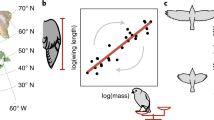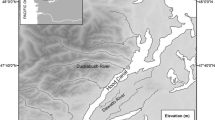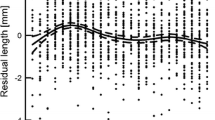Abstract
Weather and climatic conditions may impact on the phenology and morphology of birds, and thereby affect their survival rate and population dynamics. We examined the North Atlantic Oscillation (NAO), precipitation in the Sahel zone, temperatures in the wintering grounds, on the migration route, and in the breeding area in relation to arrival dates and six morphological measures (wing, tarsus, bill, and tail lengths, body mass, body condition) in a Slovak population of the River Warbler Locustella fluviatilis. Arrival dates did not change significantly over the study period, but were significantly positively correlated with NAO, although not with temperatures in wintering areas, migration route or breeding area, nor with Sahel precipitation. Four of the six morphological traits changed during the study period and part of the change in condition index can be attributed to climatic variables. We suggest changes in birds’ phenotype vary with food availability, which fluctuate according to climate events.







Similar content being viewed by others
References
Berthold P, Helbig AJ, Mohr G, Querner U (1992) Rapid microevolution of migratory behavior in a wild bird species. Nature 360:668–670
Cotton PA (2003) Avian migration phenology and global climate change. Proc Natl Acad Sci USA 100:12219–12222
Dittberner H, Dittberner W (1987) Bebrütung der Eier, Schlupf, Jungenaufzucht und postnatale Entwicklung beim Schlagschwirl (Locustella fluviatilis) (Aves, Passeriformes, Sylviidae). Zool Abhandl 42:195–223
Giannini A, Saravanan R, Chang P (2003) Oceanic forcing of Sahel rainfall on interannual to interdecadal time scales. Science 302:1027–1030
Grant PR, Grant BR (2002) Unpredictable evolution in a 30-year study of Darwin’s finches. Science 296:707–711
Grant PR, Grant BR, Keller LF, Petren K (2000) Effects of El Niño events on Darwin’s finch productivity. Ecology 81:2442–2457
Hubálek Z (2003) Spring migration of birds in relation to North Atlantic Oscillation. Folia Zool 52:287–298
Hüppop O, Hüppop K (2003) North Atlantic Oscillation and timing of spring migration in birds. Proc R Soc Lond B 270:233–240
Janowiak JE (1988) An investigation of interannual rainfall variability in Africa. J Climate 1:240–255
Kaňuščák P, Mutkovič A (1993) Nistbiologie und Verbreitung des Schlagschwirls, Locustella fluviatilis (Wolf 1810), in der Westslowakei. Falke 40:186–205
Lehikoinen E, Sparks TH, Zalakevicius M (2004) Arrival and departure dates. In: Møller AP, Fiedler W, Berthold P (eds) The effect of climate change on birds. Advances in ecological research. Academic Press, London, (in press)
Mackowicz R (1989) Breeding biology of the river warbler Locustella fluviatilis (Wolf, 1810) in north-eastern Poland. Acta Zool Cracov 32:331–437
Marchant JH (1992) Recent trends in breeding populations of some common trans-Saharan migrant birds in northern Europe. Ibis 134 [suppl1]:S113–S119
Marra PP, Hobson KA, Holmes RT (1998) Linking winter and summer events in a migratory bird by using stable-carbon isotopes. Science 282:1884–1886
Mitchell TD, Hulme M, New M (2002) Climate data for political areas. Area 34:109–112
Møller AP, Erritzøe J (2003) Climate, body condition and spleen size in birds. Oecologia 442:621–626
Nowakowski JJ (2000) Long-term variability of wing length in population of reed warbler Acrocephalus scirpaceus. Acta Ornithol 35:173–182
Nowakowski JJ (2002) Variation of morphometric parameters within the Savi’s warbler (Locustella luscinioides) population in eastern Poland. Ring 24:49–67
Ottersen G, Planque B, Belgrano A, Post E, Reid PC, Stenseth NC (2001) Ecological effects of the North Atlantic Oscillation. Oecologia 128:1–14
Peach W, Baillie S, Underhill L (1991) Survival of British sedge warblers Acrocephalus schoenobaenus in relation to West African rainfall. Ibis 133:300–305
Pearson DJ, Backhurst GC (1983) Moult in the river warbler Locustella fluviatilis. Ring Migrat 4:227–230
Piersma T, Davidson NC (1991) Confusion of mass and size. Auk 108:441–444
Przybylo R, Sheldon BC, Merilä J (2000) Climatic effects on breeding and morphology: evidence for phenotypic plasticity. J Anim Ecol 69:395–403
Smith TB (1990) Natural selection on bill characters in two bill morphs of the African finch Pyrenestes ostrinus. Evolution 44:832–842
Stenseth NC, Ottersen G, Hurrell JW, Mysterud A, Lima M, Chan K-S, Yoccoz NG, Adlandsvik B (2003) Studying climate effects on ecology through the use of climate indices: the North Atlantic Oscillation, El Nino Southern Oscillation and beyond. Proc R Soc Lond B 270:2087–2096
Szép T (1995) Relationship between West African rainfall and the survival of the Central European adult sand martin (Riparia riparia) population. Ibis 137:162–168
Todte I (2001) Beringung und Wiederfang von Schlagschwirlen Locustella fluviatilis in Ostdeutschland. Ber Vogelw Hiddensee 16:63–70
Tryjanowski P, Kuźniak S, Sparks T (2002) Earlier arrival of some farmland migrants in western Poland. Ibis 144:62-68
Tucker JJ (1978) A river warbler Locustella fluviatilis ‘wintering’ and moulting in Zambia. Bull Br Ornithol Club 98:2–4
Walther G-R, Post E, Convey P, Menzel A, Parmesan C, Beebee TJC, Fromentin J-M, Hoegh-Guldberg O, Bairlein F (2002) Ecological responses to recent climate change. Nature 416:389–395
Yom-Tov Y (2001) Global warming and body mass decline in Israeli passerine birds. Proc R Soc Lond B 268:947–952
Yom-Tov Y, Benjamini Y, Kark S (2002) Global warming, Bergmann’s rule and body mass—are they related? The chukar partridge (Alectoris chukar) case. J Zool 257:449–455
Acknowledgements
We are grateful to O. Braslavská for assistance with obtaining temperature data, M. Antczak, M. Prange, A. Surmacki for discussions on ideas in the manuscript and help with references, and two anonymous referees for suggestions for improving. P.T.’s sabbatical at Monks Wood was supported by the Foundation for Polish Science.
Author information
Authors and Affiliations
Corresponding author
Rights and permissions
About this article
Cite this article
Kaňuščák, P., Hromada, M., Tryjanowski, P. et al. Does climate at different scales influence the phenology and phenotype of the River Warbler Locustella fluviatilis?. Oecologia 141, 158–163 (2004). https://doi.org/10.1007/s00442-004-1646-8
Received:
Accepted:
Published:
Issue Date:
DOI: https://doi.org/10.1007/s00442-004-1646-8




